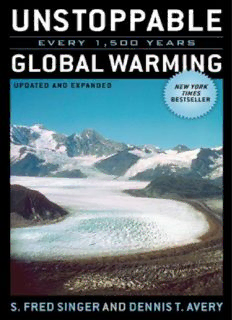
Unstoppable Global Warming. Every 1,500 Years PDF
Preview Unstoppable Global Warming. Every 1,500 Years
S. Fred Singer and Dennis T. Avery This book is dedicated to those thousands of highly qualified research scientists who have documented physical evidence of the 1,500-year climate cycle from over the entire globe. Hundreds of their studies endorse the reality of this cycle. They have gone, literally, to the ends of the Earth-often in harsh conditions, climbing tall mountains and huge glaciers, sailing frigid seas, sitting cramped at consoles in long-range aircraft, digging painstakingly in remote sites for pollen and human artifacts-to help us understand our planet's climate changes. They have done it with virtually no encouragement from the press and the public. Too often, they have had to work in the face of hostility from their colleagues in the climate modeling community who are "selling" CO2. They have done it in a sincere effort to help produce public policies that will maximize both human and ecological well-being. We applaud them and their work. The three scientists, Willi Dansgaard of Denmark, Hans Oeschger of Switzerland, and Claude Lorius of France, who led the discovery of the 1,500- year cycle, were jointly awarded the Tyler Prize (the "environmental Nobel") in 1996. However, their award citations say nary a word about the climate cycle they discovered, nor anything about its predictive power to forecast moderate climate changes. The public has remained virtually unaware that the 1,500-year cycle offers the only explanation for the modern warming that is supported by physical evidence. List of Figures ix Prologue xi Earth's Climate Timeline xiii 1 Is Humanity Losing the Global Warming Debate? 1 2 How Did We Find the Earth's 1,500-Year Climate Cycle? 21 3 Shattered Glass in the Greenhouse Theory 35 4 The Baseless Fears: Sea Levels Will Surge, Bringing Floods and Devastation 45 5 The Treaty that Would Change Earth's ClimateOr Maybe Not 55 6 The Baseless Fears: A Million Wild Species Will Be Lost Forever 75 7 Warming and Cooling in Human History 97 8 The Baseless Fears: Warming Brings Famine, Drought, and Barren Soils 117 9 The Earth Tells Its Own Story of Past Climate Cycles 127 10 The Baseless Fears: More Frequent and Fiercer Storms 161 11 How Far Can We Trust the Global Climate Models? 175 12 The Baseless Fears: Abrupt Global Cooling 187 13 The Sun-Climate Connection 191 14 The Baseless Fears: Millions of Human Deaths from Warming 201 15 Powering the Future: Can We Depend on Renewable Energy? 209 16 The Ultimate Failure of the Kyoto Protocol 221 Glossary 235 Index 247 About the Authors 259 Figure 1.1: Global Satellite Temperature Record 1979-2004 11 Figure 5.1: IPCC's 1995 Earth Temperature History 68 Figure 5.2: IPCC's "Hockey Stick," 2001 69 Figure 9.1: Chinese Temperature History 131 Figure 9.2: Siberian Temperature History 144 Figure 9.3: South African Temperature History 147 Figure 13.1: Earth's Temperatures Related to Solar Cycles 192 When Eric the Red led Norse families to settle on Greenland toward the end of the tenth century, he had no idea that he and his descendants were about to demonstrate the Earth's long, moderate climate cycle as dramatically as it would ever be done. Sailing their longships west from Iceland, the Vikings had been pleased to find a huge new uninhabited island, its shores covered with green grass for their cattle and sheep, surrounded by ice-free waters where codfish and seals abounded. They could grow vegetables for their families and hay to feed their animals through the winter. There was no timber but they could ship dried fish, sealskins, and tough rope made from walrus hide to other Norse ports to trade for what they needed. The colony thrived, growing by the year 1100 to three thousand people, with twelve churches and its own bishop. The initial settlement split into two: one on the southwestern coast and one further north also on the west coast. They did not realize that they were benefiting from the Medieval Warming, a major climate shift-which lasted for approximately four hundred yearsthat made Northern Europe about 2° Celsius warmer than it had been previously. Nor did they realize that after the warming ended, their grassy domain was doomed to five hundred years-the Little Ice Age-of icy temperatures unmoderated by the Gulf Stream that warmed the Norse settlements in Norway and Iceland. As the Little Ice Age progressed, the colony was increasingly hard-pressed to survive. The pack ice moved closer to Greenland. Supply ships had to take a more southerly route to avoid the deadly ice. Less and less hay could be harvested in the shorter, cooler summers to last the livestock through longer and colder winters. The storms got worse. By 1350, glaciers had crushed the northern Greenland settlement. The last
Description: